- Author Jason Gerald [email protected].
- Public 2023-12-16 10:50.
- Last modified 2025-01-23 12:04.
Drop D is tuning the top guitar string (or sixth string) to the D note (not the E), but leaving the rest of the strings in standard tone. Drop D is commonly used in heavy metal, hardcore, and even blues music. Before tuning the strings to drop D, you must tune your guitar to standard notes E, A, D, G, B, E. To tune your guitar accurately, use a digital tuner first. If the sixth string has been changed to drop D, you can easily play power chords and can cover songs written in drop D.
Step
Method 1 of 3: Using a Digital Tuner
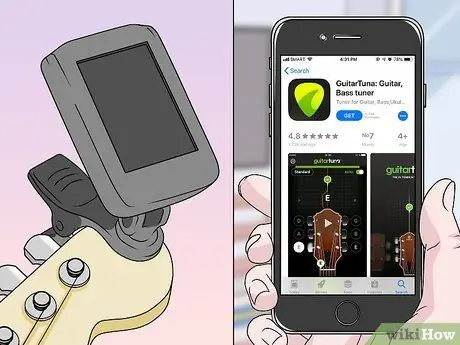
Step 1. Download or purchase a digital guitar tuner
Tuners can be found at online stores or music stores for no more than IDR 400 thousand. You can also download the guitar tuner application for free on your smartphone (smartphone). Some tuners can be plugged directly into the guitar, while others just need to be placed around the guitar as you play.
- Check reviews for the digital tuner or app you want before you buy or download it.
- Some of the well-known digital tuner brands include: D'Addario, Boss, and TC Electronic.
- Popular tuner apps include: Fender Tune, Guitar Tuna, and Pro Guitar Tuner.
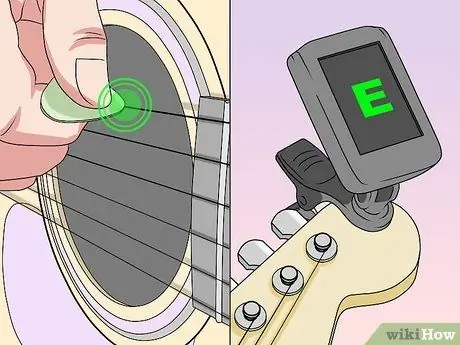
Step 2. Pluck the topmost string near the tuner
Turn on the digital tuner and place it near the guitar. Pick the topmost string (sixth string) using a pick and look at the display on the tuner screen to see the notes coming out of the top string. In standard notes, these strings should produce an E when plucked open (the strings are not pressed). Digital tuners have a screen that shows the notes coming out of the guitar strings with the needles underneath. If the needle is in the middle, it means the tone is aligned and precise. If the needle is pointing to the left or right, it means the notes are out of tune.
- The open position is to pluck the strings without pressing them against the frets (columns on the neck of the guitar with small metal rods).
- If you want to tune your guitar to drop D by listening, make sure the other strings are in sync. Otherwise, you can't use the other strings as a reference to change the sixth string to the desired D note.
- If the needle is pointing to the left, the tone is too low. If the needle is pointing to the right, the tone is too high.
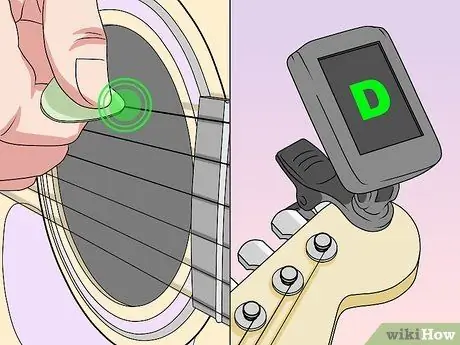
Step 3. Tune the sixth string to the D note
Pluck the top string openly. The resulting note should be E. Next, turn the knob for the top string (closest to your body, above the guitar neck) counterclockwise and look at the digital tuner. The hand will move left until the display changes to a D. Keep turning the knob until the hand is centered and the note reads D. Now the sixth string has changed to a D.
- When turning the knobs, the pitch of the guitar strings changes.
- If the guitar is slightly in tune, the digital tuner will read an E when the top string is plucked.
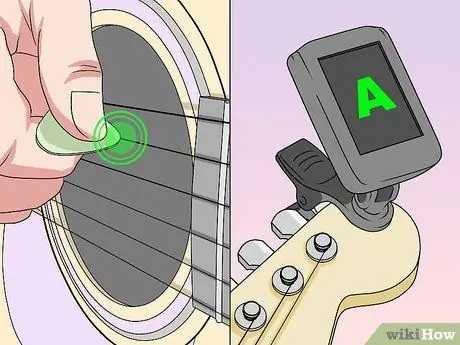
Step 4. Tune the fifth string to A
Pluck the second string from the top (or the fifth string), and look at the digital tuner. In standard tuning, the note on this string should be A. Turn the knob of the fifth string until the needle on the tuner is centered.

Step 5. Tune the fourth string to the D note
Pluck the third string from the top (fourth string) without pressing the fret and watch the notes play. Rotate the string knob until the digital tuner displays a D note with the needle centered.
- When the guitar is slightly in tune, turn the knob a little to get the D note just right.
- It's important to get the fourth string perfectly aligned if you want to tune your guitar to the drop D by listening method.
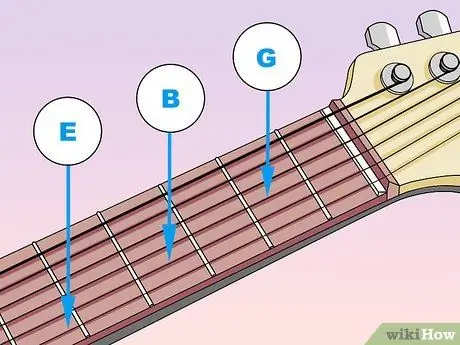
Step 6. Tune the bottom 3 strings to G, B, and E
Do the same process as for the top 3 strings to align the bottom 3 strings. The third string should be a G, the second a B, and the first (bottom) string should be an E. Turn the knob while strumming the strings to make sure the guitar is in tune.
By tuning your guitar to standard notes, you can easily tune your guitar to drop D, either by using the tuner or by any other listening method
Method 2 of 3: Tuning the Guitar to Drop D by Listening
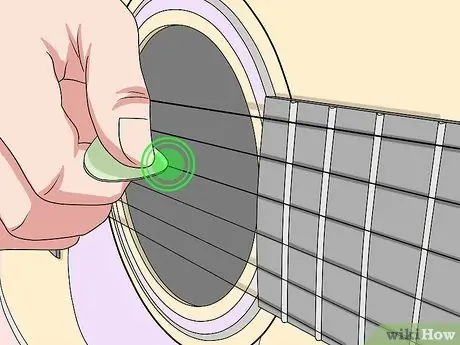
Step 1. Pluck the third string from the top
First, tune the guitar to a standard tone using a digital tuner. The third string from the top of the neck of the guitar (called the fourth string) should produce a D note if the guitar is tuned by default. Strum the strings without pressing the frets on the neck of the guitar to play a D note. This means you're strumming the strings "open."
- You have to match the sound of the top string (sixth string) with the fourth string.
- Pressing the strings against the frets or the columns on the neck of the guitar will change the pitch of the strings.
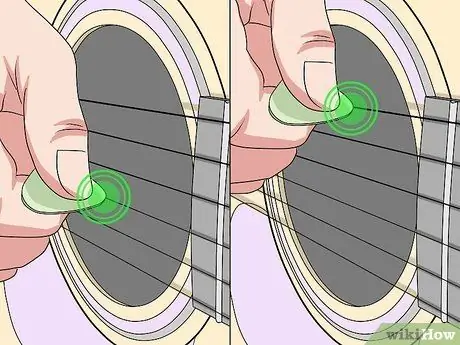
Step 2. Strum the top string while the fourth string is still ringing
Listen for the difference between the notes of the top string (sixth string) and the notes of the fourth string when plucked together. This is because in standard tuning, the sixth string will produce an E note and the fourth string is a D note.
- If the guitar is tuned by default, the 2 strings will produce different sounds when played simultaneously.
- All you have to do is lower the pitch of the sixth string until it equals the pitch of the fourth string.
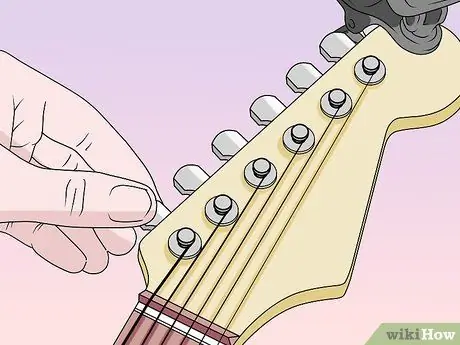
Step 3. Turn the knob of the sixth string until it is the same note as the fourth string
Turn the knob of the sixth string at the end of the neck of the guitar counterclockwise to lower the pitch to D. Listen for the vibrations on the 2 strings and stop turning the knob when it's in sync. You will know if the two strings are in sync if there is no discord and the notes coming out of the two strings are the same.
Tuning the guitar by listening method takes practice and experience
Method 3 of 3: Tuning the Guitar to Drop D Using Harmonics

Step 1. Touch the top string at the 12th fret
Touch the metal part that divides the 11th and 12th frets on the top string (sixth string). Playing the harmonics is touching the strings and releasing them quickly.
- The frets are the columns on the neck of the guitar.
- Under normal circumstances, you should press down on the center of the fret to sound the strings. However, to sound the harmonics you just need to touch the strings on the small metal rods between the frets.
- Harmonics are sounds produced by the vibrations between the strings and the metal rods on the guitar frets. It may be easier to sound harmonics than complete notes.
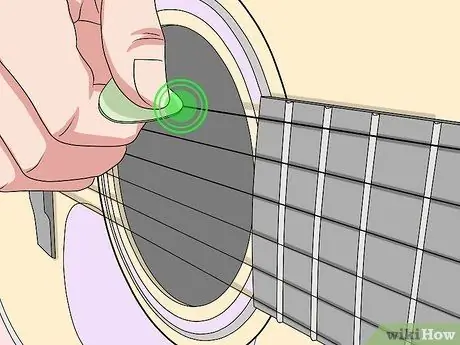
Step 2. Strum the sixth string and let the harmonics come out
Strum the top string while placing your finger on the small metal rod between the 11th and 12th frets, then listen for the metallic sound that comes out of the guitar. This is the harmonic tone. Match this note with the D on the fourth string.
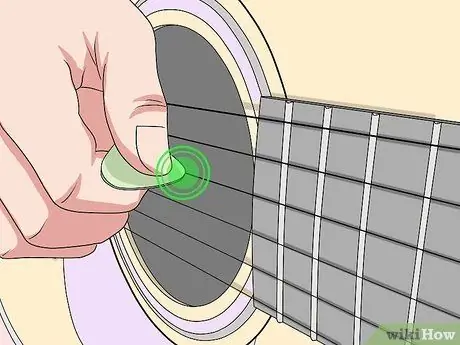
Step 3. Pluck the fourth string openly
Strum the fourth string without pressing the fret (open position) when you play the harmonics. The sound that comes out will sound out of tune if the guitar is tuned by default because the top string is tuned to an E and the fourth string is tuned to a D.
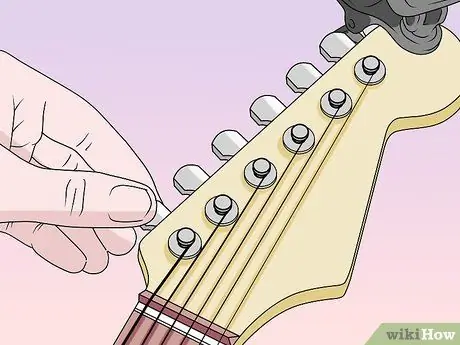
Step 4. Turn the knob of the sixth string until the pitch is the same as the fourth string
Turn the knob of the sixth string until the notes are in sync. If the strings are not in sync, the notes of the two strings will clash and a discordant sound will be heard from the guitar. If the two strings are matched, your guitar is tuned to drop D.






